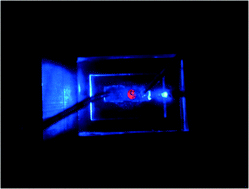A total internal reflection photoluminescence (TIRPh) device employing an easily fabricated PMMA/PDMS waveguide system provides a detection limit comparable to the best reported results but without using an excitation filter. The optical mechanism is similar to total-internal-reflection-fluorescence (TIRF) but uses a ruthenium-based phosphorescent dye (Ru(dpp)3) deposited on the PMMA core, motivating the generalized term of photoluminescence to include both fluorescence and phosphorescence. An enzymatic hydrogen peroxide (H2O2) biosensor incorporating catalase was fabricated on the TIRPh platform without photolithography or etching. The O2-sensitive phosphorescence of Ru(dpp)3 was used as a transduction mechanism and catalase was used as a biocomponent for sensing. The H2O2 sensor exhibits a phosphorescence to scattered excitation light ratio of 76 ± 10 without filtering. The unfiltered device demonstrates a detection limit of (2.2 ± 0.6) μM with a linear range of 0.1 mM to 20 mM. The device is the first total internal reflection photoluminescence based enzymatic biosensor platform, and is promising for cost-effective, low excitation interference, field-portable sensing.
